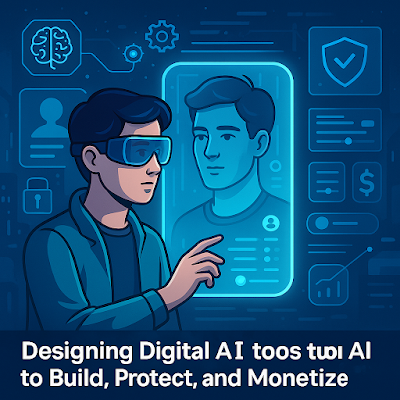Introduction: Your Identity Is Now a Platform
In the age of generative AI, you are no longer just a user of the internet—you are a brand, a data stream, and a digital persona. By 2030, building your digital self is not just about social media presence—it's about using AI to shape how you're seen, protect your integrity, and unlock income streams. This article explores the full lifecycle of the digital self: design, protection, amplification, and monetization.
1. The Foundations of Your Digital Self
Your digital self is the sum of your:
-
Online content (posts, blogs, videos)
-
Communication style (tone, language, emojis)
-
Public interactions (likes, shares, comments)
-
Visual identity (avatars, profile photos, style)
-
Algorithmic behavior profile (engagement patterns, time online)
AI tools analyze and shape all of these—and they’re becoming co-creators of your online identity.
2. Designing Your Personal AI Co-Pilot
Imagine having an AI assistant trained on your:
-
Writing voice
-
Knowledge domains
-
Decision-making style
-
Communication tone
You can now fine-tune models like GPT, Claude, or open-source LLMs to create your digital twin that:
-
Replies to emails in your tone
-
Writes social content you’d likely post
-
Represents you in forums or comment sections
This co-pilot becomes the first layer of your digital persona.
3. Building Your Visual Identity with Generative Tools
Your face, style, and brand can now be AI-generated:
-
Profile avatars via Midjourney, DALL·E, or Runway
-
Branded image themes for content consistency
-
AI-generated thumbnails for YouTube, TikTok, and Reels
-
Virtual fashion design and avatar skin creation in VR/AR platforms
Visual coherence boosts trust, recognizability, and follower retention.
4. Protecting Your Digital Self with AI
As your presence grows, you need to defend it:
-
AI watermarking: Prove authorship of your creations
-
Reputation monitoring tools: Detect misuse, impersonation, or defamation
-
Synthetic media detection: Spot deepfakes of your face or voice
-
Privacy shields: Use differential privacy or federated learning to anonymize sensitive data
Services like Clearview, Hive, and Pimeyes track visual identity misuse. Legal protections are lagging—but AI tools can help you stay ahead.
5. Authenticity vs. Automation: Where to Draw the Line
If your AI is doing the talking, is it still you?
-
Should you disclose when a bot speaks for you?
-
What happens when your digital self performs better than your physical one?
-
Can you delegate emotional labor (e.g., responding to DMs) to AI?
Balancing authenticity with automation is an ethical and strategic decision.
6. Monetizing Your Digital Self
AI empowers creators to monetize more efficiently:
-
Creator economy tools: AI content schedulers, SEO assistants, and audience analytics
-
Tokenized identity: Launching personal tokens or NFTs tied to your output
-
AI-powered courses: Creating scalable educational content in your voice
-
Synthetic influencers: Licensing your digital twin for branded content
You become a micro-business powered by your personality and data.
7. Digital Self in the Workplace
Professionals are also building AI-enhanced identities:
-
Career portfolios generated by AI summarizers
-
Real-time meeting avatars that echo your style
-
Auto-pitching bots that respond to job leads
Your résumé is no longer static—it’s interactive, AI-augmented, and always evolving.
8. Identity as an Ecosystem: Interoperability Across Platforms
The future digital self is portable and composable:
-
Verified credentials via blockchain (education, experience, achievements)
-
Reputation scores from platforms synced via APIs
-
Identity wallets storing all aspects of your persona
You should be able to take your “self” with you, just like currency or data.
9. Mental Health and the Fragmented Self
The more personas you manage, the more fragmented your self may become. Risks include:
-
Burnout from managing multiple platforms and versions of yourself
-
Identity confusion between the AI-generated and the real
-
Impostor syndrome when your digital self outperforms you
Mental wellness tools, mindfulness AI, and digital detox protocols will be essential.
10. The Long-Term Arc: Post-Human Identity and Legacy
Your digital self may outlive you. Already, services exist that create “griefbots”—digital replicas for loved ones to talk to after you’re gone.
Future possibilities:
-
Uploading consciousness into AI frameworks
-
Designing your posthumous social presence
-
Selling or licensing your identity for future projects
Your identity becomes a legacy asset.
Conclusion: Identity Is a Project, Not a Static Trait
In the age of AI, identity is designed, trained, deployed, and protected. The tools are here—but the strategy is up to you.
You are no longer just building a brand. You’re building a being.
And in 2030, your digital self may be your most valuable creation.

